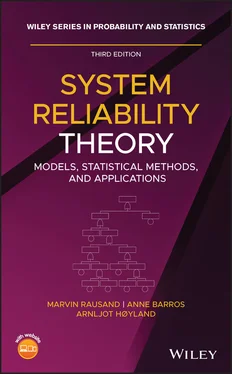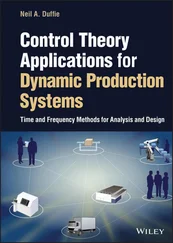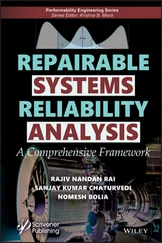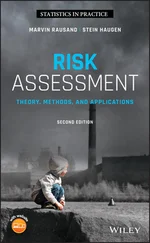10 2.10 Refer to the SADT functional block (see Figure 2.3) and list all the inputs, controls, and resources you need to bake a pizza. The output from the function is the new‐baked pizza. How would you set up the performance criteria for your pizza?
11 2.11 Based on an Internet search, explain what is meant by a CONOPS and list its main elements.
12 2.12 Based on an Internet search, list the main elements that are typically included in a system requirements document (or a system requirements specification).
13 2.13 Establish an RBD of the braking system of a family car. 3
14 2.14 Consider a voted oo structure. The voting can be specified in two different ways:– As the number out of the components that need to function for the system to function.– As the number of the components that need to fail to cause system failure.In the first case, we often write oo:G (for “good”) and in the second case, we write oo:F (for failed).Determine the number such that a 2oo4:G structure corresponds to a oo4:F structure.Determine the number such that a oo:G structure corresponds to a oo:F structure.
15 2.15 Are there any examples of standby redundancy in a family car? Justify your answer.
1 Aslaksen, E.W. (2013). The System Concept and Its Application to Engineering. Heidelberg: Springer‐Verlag.
2 Blanchard, B.S. and Fabrycky, W.J. (2011). Systems Engineering and Analysis, 5e. Boston, MA: Pearson.
3 Einstein, A. and Infeld, L. (1938). The Evolution of Physics. Cambridge University Press.
4 Lambert, M., Riera, B., and Martel, G. (1999). Application of functional analysis techniques to supervisory systems. Reliability Engineering & System Safety 64 (2): 209–224.
5 Marca, D.A. and McGowan, C.L. (2006). IDEF0 and SADT: A Modeler's Guide. Auburndale, MA: OpenProcess.
6 Ødegaard, S. (2002). Reliability assessment of a subsea production tree. Project thesis. Trondheim, Norway: Norwegian University of Science and Technology.
7 U.S. Air Force (1981). Integrated Computer Aided Manufacturing (ICAM) Architecture. Part II. Volume IV, Functional Modeling Manual (IDEF 0). Technical Report AFB AFWAL‐TR‐81‐4023. Wright Patterson Air Force Base, OH: Air Force Materials Laboratory.
8 U.S. DoD (2001). Systems Engineering Fundamentals. Fort Belvoir, VA: Defense Acquisition University Press.
1 1IEV defines indenture level as the “level of subdivision within a system hierarchy” (IEV 192‐01‐05).
2 3You may need to search the Internet to find technical information on the braking system.
Chapter 3 Failures and Faults
3.1 Introduction
Failure is the most important concept in any reliability study, where typical questions addressed include:
How long time will the item, on the average, be able to operate until the first failure occurs?
What will the frequency of failures be? How many failures per year should we expect?
What is the probability that the item will operate without failure during a specified time interval?
If an item is demanded, what is the probability that it will fail to perform as required?
If we do not have a clear understanding of what a failure is, the reliability study may be of limited value. The term failure is used frequently in our daily language with many different interpretations and we also use a plethora of terms with similar meaning. Among these terms are blunder, breakdown, bug, collapse, defect, deficiency, error, fault, flaw, impairment, malfunction, mishap, mistake, and nonconformance.
How the term failure is interpreted varies between professional disciplines. Engineers working with quality, maintenance, warranty, safety, and reliability may have quite different opinions about whether or not a particular event constitutes a failure.
To perform a reliability study, it is important to understand thoroughly what is meant by the term failure in the context of reliability. Several definitions of failure have been proposed. IEV 192‐03‐01, for example, defines failure as “loss of the ability to perform as required.”
This chapter is concerned with failures of single items only. Aspects related to interactions between several items in a system are treated in Chapter 4. Before continuing the discussion of failures, the concepts of states, transitions, and operational modes need to be introduced.
3.1.1 States and Transitions
At a given time, an item may be in one out of several states . The functions performed in one state may be different from the functions performed in other states. The item changes state by a transition . The transition may be automatic or manual and may occur at a random time or as a result of a command. Complicated items may have a high number of states and transitions.
Example 3.1 (Safety valve)
Consider a safety valve with a hydraulic fail‐safe‐close actuator. The valve is held open by hydraulic pressure during normal operation. When a specific critical situation occurs, a closing signal is sent to the safety valve and the valve closes by the force of the fail‐safe actuator. The valve has two functioning states: open and closed. Transitions between these two states are facilitated by the actuator. The states and transitions are shown in Figure 3.1.

Figure 3.1States and transitions for a safety valve.
The essential function in state “open” is to provide a conduct for the medium/fluid through the valve, and the essential function in state “closed” is to stop the flow through the valve. An auxiliary function for both states is to contain the fluid and thereby to prevent leakage to the environment.
Remark 3.1 (States and transition)
The difference between states and transitions is clear and intuitive for many items, but may be confusing for some items. The concepts of states and transition should therefore be used with care.
A complicated item may have many operational modes, and one or more functions for each operational mode. Operational modes may include normal operating modes, test modes, transition modes, and contingency modes induced by failures or operator errors. The establishment of the different operational modes is recommended for two reasons:
1 It reveals functions that might be overlooked when focusing too much on the essential functions.
2 It provides a structured basis for identifying failure modes that are connected to, and dependent on, the given operational mode.
Operational modes are therefore an aid in identifying both functions and failure modes. Failure modes are discussed in Section 3.4.
Even if we are able to identify all the required functions of an item, we may not be able to identify all the potential failures. This is because each function may fail in several different ways. No formal procedure seems to exist that help us to identify and classify all the potential failures.
In this section, we consider a specific item within its boundary in its intended operating context. Failure is, in many applications, a complicated and confusing concept. We try to shed some light on this concept and start by defining failure of an item as:
Definition 3.1 (Failure of an item)
The termination of the ability of an item to perform as required.
The following comments to Definition 3.1may be given:
Читать дальше













